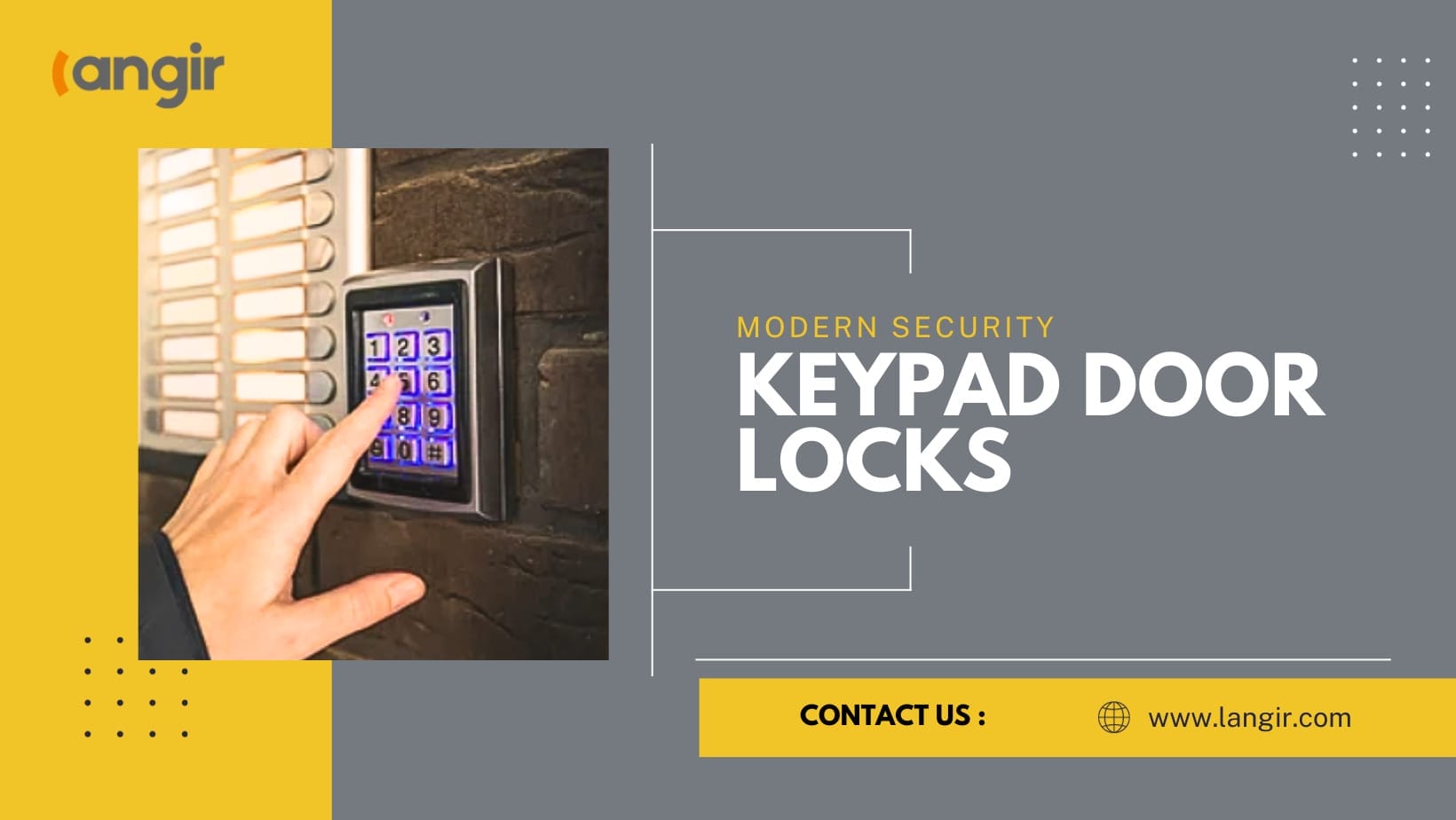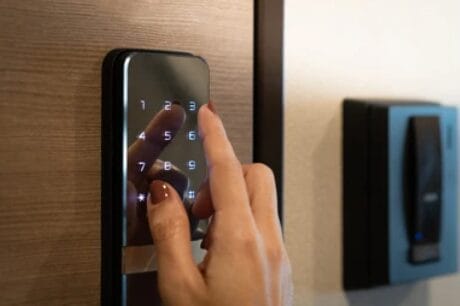
Tired of the perpetual jingle of keys and the anxiety that accompanies the thought of losing them? The era of fumbling with keys is a common frustration many of us can relate to. However, the good news is keypad door locks have emerged as a solution to this age-old problem. Keypad door locks eliminate the need for physical keys, replacing them with a button or digital interface that simplifies access.
Beyond the fundamental shift in entry methods, these locks offer a range of advantages. The foremost is heightened security through features like customizable access codes, allowing you to grant temporary or permanent access to different individuals. Ease of use is another hallmark of keypad locks. All you must do is memorize a personal code and make your daily routine of locking and unlocking doors a seamless experience.
Let’s delve into everything you need to know about keypad door locks and how they provide a smarter and more convenient home security experience.
How Does a Keypad Door Lock Work?
The working of a keypad lock involves a user inputting a predetermined numeric code through the touchpad or keypad. This entered code is then transmitted to the lock’s internal electronic control system, which meticulously authenticates it against stored data.
For the lock to release its bolt, a small current is required to power the electronic components responsible for the authentication process. Batteries or a wired power source typically provide this minimal current and ensure the functionality of the electronic system.
Upon successful verification, the control system signals the lock mechanism to release the bolt, allowing the door to be opened. In case you enter an incorrect password multiple times, the keypad lock may employ a self-protection feature that automatically relocks the door for a specified period, typically ranging from 10 to 15 minutes. This action is useful to deter unauthorized access!
Types of Keypad Door Locks
Push-to-exit buttons or snap switches are often used as door locks, but they aren’t as efficient as keypad door locks.
Here are some top types of keypad door locks you should know:
How to Install a Keypad Door Lock?
Here’s the step-by-step guide on how you can install a keypad lock in your home or commercial building:
Begin by gathering all necessary tools and ensuring the new keypad door lock is compatible with your door. Read the manufacturer’s instructions thoroughly before proceeding with the installation.
Using a screwdriver, unscrew the bolts inside the door and remove the deadbolt face. Take out the old deadbolt and lock cylinder, ensuring the dimensions align with the new lock. Verify the circular hole’s appropriateness in the door edge.
Utilize a screwdriver to fully extend the deadbolt plunger. Slide the new deadbolt into place, ensuring the “D”-shaped hole aligns at the center of the door hole. Confirm that the bolt face sits flush with the edge of the door for proper functionality.
Securely attach the mounting plate of the keypad lock on the inside of the door, aligning it with the touchpad on the outer surface. Place the lock assembly, including the battery pack, electric motor, controls, and data wire, onto the mounting plate.
Position the assembly cover and securely fasten it using the provided screws. This step ensures the protection and stability of the keypad lock components.
Before completing the installation, test the keypad lock to ensure all components are functioning correctly. Enter the code and confirm smooth locking and unlocking. If adjustments are needed, follow the manufacturer’s instructions to fine-tune the keypad lock for optimal performance. This step is crucial for guaranteeing the security and reliability of the newly installed keypad door lock.
Benefits of Using Keypad Door Locks
Here are some exciting benefits of using keypad locks:
Enhanced Security
Keypad door locks offer a heightened level of security by replacing traditional key mechanisms with personalized numeric codes. This keyless entry method eliminates the risk of lost or stolen keys, reducing vulnerabilities associated with unauthorized access.
Furthermore, many keypad locks boast advanced security features. They allow you to set temporary access codes and integrated alarm systems, providing you with peace of mind and robust protection against potential security threats.
Changeable Codes
The flexibility of changeable codes is a significant benefit of keypad door locks. You can easily alter access codes, granting temporary or permanent access to different individuals without the need for physical key duplication. This feature proves invaluable in situations such as welcoming guests, accommodating service providers, or managing access for household members.
Easy Installation
One of the standout advantages of keypad door locks is their user-friendly installation process. Unlike complex traditional lock replacements, keypad locks often require minimal tools and expertise. Homeowners with basic DIY skills can successfully install these locks, saving both time and money. This straightforward installation contributes to the widespread adoption of keypad door locks.
Best Keypad Door Lock Options
Let’s discuss Piezo Keypads that serve as the best keypad locks:
Langir’s Touch Metal Piezo Keypads
Our Touch Metal Piezo Keypads are a pinnacle of reliability and durability designed for challenging environments. Crafted from a single piece of solid metal, these keypads are exceptionally rugged, making them ideal for applications where resilience is paramount. The IP68 certification ensures dust and water resistance, making them impervious to harsh conditions, including exposure to seawater and detergents.
A standout feature is their maintenance-free design, as these keypads boast no moving parts. The rear potted switching unit adds an extra layer of protection, sealing against all forms of contamination and preventing freezing in extreme temperatures. The flexible design allows for either anodized printing or laser engraving for the layout, catering to diverse user preferences.
In terms of electrical specifications, the Touch Metal Piezo Keypads operate with a standard output in a matrix/common bus configuration. The contact arrangement is SPST N.O. (Single Pole, Single Throw Normally Open), providing reliable switching capabilities. For seamless integration into different systems, these keypads offer multiple electrical connection options, including flat cable or pins.
Buying Guide for Choosing the Best Keypad Door Lock
Choosing the best keypad door lock for your residence or office requires careful consideration of various factors to ensure security, functionality, and compatibility. Here’s a guide to help you make an informed decision:
When selecting a keypad lock, prioritize advanced security features to fortify your home or office. Look for locks with anti-tamper alerts, encryption, and built-in alarms that provide an additional layer of protection. Consider models that offer temporary access codes for guests, granting flexibility and control over who enters your space.
The type of keypad lock you choose significantly influences the level of technology and functionality it offers. Decide between mechanical, electronic, or smart keypad locks based on your preferences and specific requirements.
Mechanical locks provide simplicity, while electronic locks introduce keyless entry. Smart locks, on the other hand, offer advanced features like remote access and integration with home automation systems. Assess your technological needs to determine the most suitable type for your home or office.
Consider the ease of installation when choosing a keypad door lock. Some locks are designed for straightforward DIY installation, making them accessible for users with basic skills.
Others may require professional assistance, so it’s crucial to assess your comfort level with the installation process. Ensure that the lock is compatible with your door’s specifications, including size and type, for a seamless integration.
Prioritize the durability of the keypad lock by selecting models constructed from robust materials such as metals, stainless steel, or reinforced alloys. This ensures longevity and resilience against wear and tear.
In addition, consider the weather resistance of the lock, especially if it will be exposed to outdoor elements. Opt for locks with weather-resistant features to maintain optimal performance in various conditions.
If you have a smart home system, consider the compatibility of the keypad lock with popular platforms such as Z-Wave or Zigbee. Ensure that the lock can integrate seamlessly with other security devices or home automation systems you may already have in place. Compatibility enhances the overall efficiency and interconnectedness of your home security setup.
Last but definitely the important point is to consider your budget! Your budget for the keypad lock should include not only the initial cost but also long-term maintenance expenses and potential subscription fees for smart locks. Understanding the overall cost helps you make a well-informed decision that aligns with your financial considerations.
FAQs
What are the disadvantages of keypad locks?
There’s a risk of code exposure, as onlookers may observe or deduce your entry code. Hackers can also get into your smart home system to get the code of your keypad door. Not only this but if you have electronic keypad locks, they are vulnerable to power outages, requiring alternative access methods during such events.
How do keypad door locks get power?
Keypad door locks commonly obtain power through batteries or a wired connection. In battery-operated models, replaceable or rechargeable batteries supply the necessary electrical power for the lock’s electronic components. Some locks may also feature wired connections, drawing power directly from the building’s electrical system.
Why is my keypad door lock not working?
In case your keypad door lock is not working, several potential reasons could be affecting its functionality. First and foremost, depleted or improperly inserted batteries may be the culprit, so it’s essential to verify their condition and positioning. Also, check for loose or corroded connections in the battery compartment, as these issues can disrupt the power supply.
Conclusion
Keypad door locks offer a secure and convenient solution for modern access control, eliminating the need for traditional keys. Their diverse applications, ranging from residential to commercial settings, underscore their adaptability. While providing enhanced security features and ease of use, you should be mindful of potential issues such as code exposure and reliance on power sources.
In case you are searching for the best keypad lock for your home, Langir’s Touch Metal Piezo Keypads are the best. We have crafted it using high-quality materials, and it works with excellent efficiency. So, get in touch with us and grab your home security solution now!
Send your inquiry now
All Langier News:
Read Moreelectronica 2024 Hall-Stand No.: A2 160 November 12-15, 2024 Tr...

 English
English 简体中文
简体中文









